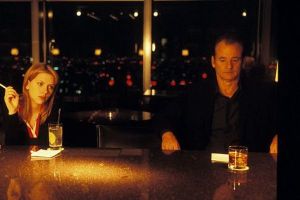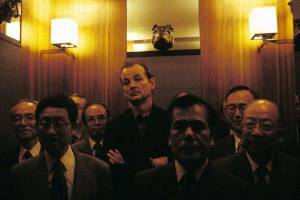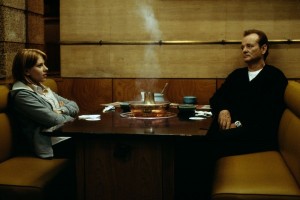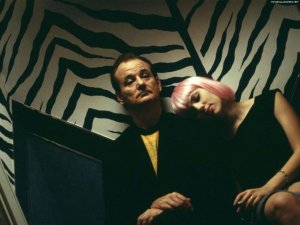Originally Posted August 25th, 2010
Come on. We all knew this was how it was going to turn out. No matter how badly we wanted to believe they could do it, too much time has passed. When we all heard that Sylvester Stallone was going to unite the biggest action heroes of the last thirty years under one blood-soaked banner, the internet's collective jubilation was laced with a deep-seated fear that this would be an impossible feat to pull off. In trying to recapture the spirit of the 80’s action flick, The Expendables plays more like a relic, just with modern trimmings. Its aging stars and uninspired script, which must have been about twenty pages if one-liners were excluded, make you wonder if this was a genre that should have just stayed put in the more reptilian crevices of your memory. Even when trying to deliver the gratuitous explosions and gunfire that made the likes of First Blood and Commando genre classics, The Expendables can’t get a grip on the advances of special effects, and sacrifices authenticity for the sake of one-upmanship.

After a ponderously slow first few minutes, we meet the titular group of manly-men mercenaries, including Jet Li, Dolph Lundgren, Terry Crews, Randy “The Natural” Couture and the leader of the outfit, writer/director Sylvester Stone. The foreplay is brief, as it's mere moments after the introductions that a pirate is literally blown in half by a shotgun blast. You might say the dismemberment and copious CG blood are holdovers from Stone’s last directorial outing, Rambo, as it’s a good barometer for what the next hundred or so minutes are going to be like.
After successfully returning to their tattoo parlour/bar/all-around-man-cave run by Mickey Rourke, Sly accepts a suicide mission from a CIA handler played with deadly seriousness by Bruce Willis, in an overly advertised and far too brief scene featuring Stallone, Willis and Arnold Schwarzenegger in the same room. It’s hard not to bro-out a little during the scene, as Schwarzenegger’s entrance is punctuated by an inexplicable divine light, while the winks and nods between the three great apes are telegraphed with the finesse of a bat to the face.
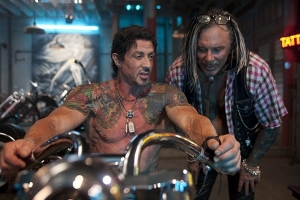
Being the good soldier of fortune that he is, Barney signs up the crew to take down a military dictator in the sinisterly named island nation of Vilena, where there’s some scheme involving coke fields, an ex-CIA spook and Steve Austin. There are betrayals, unrequited loves and perfunctory speeches about the soulless life of a mercenary, none of which are handled with much subtlety, but subtlety isn’t what this movies about now is it? It’s about shit blowing up, bones being busted, SMASH-BAM-POW-GAAAR. Which isn’t so much The Expendables's only redeeming trait as it is pretty much its only trait period.
This is an action movie from start to finish, so it won’t confuse anyone who accidentally walked in thinking this was Eat Pray Love. To his credit, Stallone knows how to stage shoot-outs and fist-fights, and boy are there plenty. The number of baddies disposed of by Stallone’s motley crew borders on genocidal, and it’s a rare feat that an action scene can be so skilfully chaotic that a man’s head literally blowing up isn’t the centre of attention. The action is by no means flawless, as all the gunfire and exploding can be desensitizing by the time the film reaches its bombastic final twenty minutes, and a pair of car chases in the film’s first half may be some of the worst filmed in recent memory.
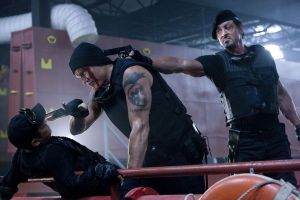
What really holds back blood-n-guts orgy are the attempts made to use newer special effects to beef up the skirmishes, the apparent aim being to make every other action movie obsolete. It was probably because of Rambo that Stallone decided you could get more blood for less by adding it in during post-processing. And hey, while we’re at it, why not get rid of the rigidity inherent in actual explosions and just code it for cheap? It’s understandable really, audiences just aren’t wowed by violence the way they once were and the solution is always just to add more and more. But in doing so, The Expendables betrays the very films it seeks to honour. Sure John McClane only blows away about a dozen dudes in Die Hard, but it looked real. When the roof of the Nakatomi Plaza blew up, you were watching a giant explosion consume a building and it felt real. With TheExpendables, the sheer overload of the set pieces combined with the CG effects, which range from passable to laughable, dissolves what little sense of reality the film wants to maintain.
This wouldn’t be quite so frustrating if the movie were good at anything besides action, but Stallone’s words don’t flow nearly as well as his fists. When your characters are a biker gang of Neanderthals, there’s no real room for character development, and attempts at being reflective about the whole killing business feel shoehorned in. The greater shame is that the film’s many, many one-liners, a staple of the genre, are almost entirely forgettable, and it doesn’t help that between various accents and Stallone’s growling that much of the line delivery can be tough to interpret. But again, brilliant writing isn’t one of the things The Expendables is aiming to achieve and it looks to supplement words with casting. Despite his noticeably aged face, Stallone’s giant everythings ensure he’s who you imagine leading a suicide squad of mercs, and Statham brings his trademark frame and charm to what few scenes he’s in that require actual acting. It’s a hell of a crew Stallone’s assembled, almost to a fault. Crews is under-utilized and it’s easy to forget that Couture is even in this movie, although he does once and for all finish the debate between the UFC and WWE fans.

Be wary of advertisements claiming that this will be the first and only time we’re going to see such a macho medley of beefheads join forces, as receipts have been strong and the film’s ending presents future jobs for The Expendables as a certainty (which also enforces how much of a misnomer their title is). But what could have been a testosterone fuelled tribute to filmmaking of years past turned out to be a retread that simply drags out a genre and cast that’s just not as youthful as it once was. You got me this time Stallone, but by invoking the hallowed images of your past works and actors like you, you set yourself up to sit in the shadows of the classics that defined the action movie. And no amount of CG blood can cover that up.
2 out of 5
Directed by Sylvester Stallone
2010, USA



